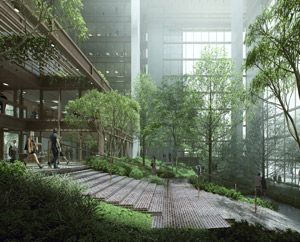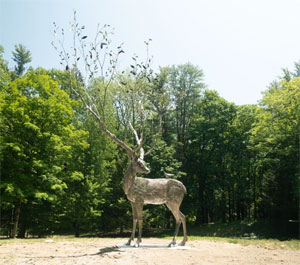Back to the Garden
John Haberin New York City
Helen Mayer and Newton Harrison: Portable Orchard
2024 Harlem Sculpture Gardens
Alexis Rockman and Tiril Hasselknippe
It was 1972, and environmentalists were desperate. At least Helen Mayer and Newton Harrison were, and they sought a "survivalist alternative" where you might never expect it, in a work of art.
Their Survival Piece (the fifth of seven) made its debut that year in the gallery at Cal State Fullerton. In its Portable Orchard, nature had an assist from recycled redwood and artificial light. Now the Whitney recreates it, and one can hear their urgency. "To survive as a species," they wrote, "we are going to have to learn how to grow our own food and take care of ourselves."  So why has it gone all but forgotten? And why does it look so calm, so composed, and so green?
So why has it gone all but forgotten? And why does it look so calm, so composed, and so green?
For at least six months, Harlem, too, becomes a garden. At the very least it welcomes one, only not with flowers. With Harlem Sculpture Gardens, its parks become one long sculpture garden, with echoes all across the west side. The West Harlem Art Fund, NY Artist Equity, and community curators invite nineteen artists into three strips of playgrounds and greenery. And you can see them as a garden, from the lake and willow trees at its south to denser woods on every side. Sculpture will soon be gone, but Harlem may never look the same again.
Or so they hope, for change comes slowly, and even now the visitor in search of art may feel like a pioneer. The show feels thrown together on the cheap, with neither maps, photos, nor closing dates on its Web site and signs fallen away. If you cannot find the half of it, and I did not, you can still get better acquainted with the neighborhood. Just to see kids ascending a red, free-form jungle gym would be worth a trip to Morningside Park. To recognize the dignity and diversity of the community should be a requirement for all New Yorkers. If the art is largely detached and disappointing, that has its lessons as well, and other artists, too, like Alexis Rockman and Tiril Hasselknippe remember summer.
When a lemon was art
The Harrisons were themselves survivors. Like the fruit of their "sustainable food system," they lived to a ripe old age. They would be in their nineties were they alive today. Their indoor citrus grove includes all that one might wish, including lemons, limes, grapefruit, and naval and mandarin oranges, each carefully labeled. On the First of July, just days after the opening at the Whitney, young fruit had already begun to appear. As if to proclaim their eco-friendliness, they were still green.
To appreciate it, though, you may have to get past the rhetoric. The enterprise sounds not just urgent, but downright bureaucratic. It speaks of not natural farming, which in any case takes more land to feed the millions, but natural farming practices—and they are not just obsolete, but "cannot be taken for granted." You must get past the contradictions as well. This may be sustainable agriculture, but not for eating. If it makes you think of Rirkrit Tiravanija, "relational esthetics," interactive art, free food, and sharing, forget it, and do not touch.
Perhaps the contradictions come with the territory, where fears mix with love. The Whole Earth Catalog appeared in 1972, Silent Spring was ten years old, and the Whitney has copies of both. Like the EPA, established tin 1970, they attest to urgency, but also to hope. Artists may have felt a sense of desperation as well, as late modern art gave way to criticism and chaos. Besides, fears are easier to understand than ever in light of climate change. Yet artists like Maya Lin do not just conserve the environment, but transform it.
The orchard flourishe all the same. The Whitney has removed its eighth-floor partitions, leaving a wide-open room with planters in neat rows. They share their redwood hexagons with parallel light tubes directly above. As trees grow, their peaks extend into those upper hexagons as well. Other survival pieces included a hog pasture, a fishery, and an entire farm, all portable. Here a uniform design and strong colors carry the day.
It is tendentious all the same. This is not the future, sustainable or otherwise. It is art, and a true New York landmark shows what that might mean. Back from college in the 1970s, I was rediscovering the city, its neighborhoods and its architecture. The Ford Foundation on East 42nd Street offered a glorious respite from my minimum-wage job barely a block away. Like the Harrisons, it, too, took nature indoors and artifice into nature.
Finished in 1967, its twelve stories of offices surround a soaring atrium—a place for walking, sitting, and contemplation. Greenery blossoms out from the balconies and rises from the floor. A collaboration between Dan Kiley, the landscape architect (whose other landmarks include Gateway Arch National Park in St. Louis), and Kevin Roche and John Dinkeloo (who also designed the Met's American wing), it brought a temperate environment and a seamless flow of plants, trees, pink stone, and rusted steel. It has its surfeit of good intentions, too, no doubt. It has after all, been the Ford Foundation Center for Social Justice since restoration in 2019 (and I described it at greater length then). Still, by comparison, that citrus grove is a lemon.
The greening of Harlem
When you think of Harlem, a garden may not come to mind. You may think first of a cultural history that did not end with the Harlem Renaissance and the stateliness of Strivers Row, concrete and crime, family histories, or racism and neglect. New York summer sculpture has come before to Marcus Garvey Park across town—featuring Simone Leigh, Maren Hassinger, and "InHarlem," a home for local artists curated by the Studio Museum in Harlem. Those with long memories will take pride in the protests that blocked Columbia University from appropriating Morningside Park on behalf of a gym. They could not rescue the park from what were to be New York's darkest decades. Yet the greenery is there.
That park, St. Nicholas Park, and Jackie Robinson Park add up to add up to practically a single landscape running a block wide and forty-five blocks long. Each rests on a cliff or terrace with a single long path below, making it a bit easier to find the art. Morningside Park, by far the lushest, accounts for the name of Columbia's neighborhood, Morningside Heights. It has never looked half so open. A rec center easily upstages Jackie Robinson Park, which comes to a dead end in a rail overpass and stairs that you may hesitate to climb. Still, you can appreciate the art all the more should you find it.
 Harlem Sculpture Gardens treats long-term sculpture outside the park, at City College and in plazas, as just part of the show. Three alone suggest the problems and potential of public art. Gabriel Koren and Algernon Miller serve up a monument to Frederick Douglass at the northwest corner of Central Park, outshone by triangular slabs for benches and a star chart caved into a black wall. A mile or so north, Alison Saar animates a statue of Harriet Tubman with an easy stride, a train of bronze behind her, and hands, feet, and symbols etched in her clothing and base. Richard Hunt, always at his best outdoors, has his usual elegance just west on 125th Street. Do not blame him if his claim to a uniquely black abstraction looks an awful lot like a bunker.
Harlem Sculpture Gardens treats long-term sculpture outside the park, at City College and in plazas, as just part of the show. Three alone suggest the problems and potential of public art. Gabriel Koren and Algernon Miller serve up a monument to Frederick Douglass at the northwest corner of Central Park, outshone by triangular slabs for benches and a star chart caved into a black wall. A mile or so north, Alison Saar animates a statue of Harriet Tubman with an easy stride, a train of bronze behind her, and hands, feet, and symbols etched in her clothing and base. Richard Hunt, always at his best outdoors, has his usual elegance just west on 125th Street. Do not blame him if his claim to a uniquely black abstraction looks an awful lot like a bunker.
Public sculpture will always have a slightly defensive posture. If things loosen up with emerging artists in the parks, they still seem obliged to learn from the past. They are good students. Intersecting red steel loops by Miguel Otero Fuentes could have come from any of a dozen artists fifty years ago. Weathered steel from Michael Poast brings the rough edges of the city to David Smith. Steel for Iliana Emilia Garcia extends vertically, and it may take a moment to realize that it forms literal high chairs.
Each is adapting late modern sculpture to experience. For Carole Eisner, that means turning Smith's welded planes into a mother and child, in bright yellow. For Zura Bushurishvili, it means lending a tall, gaunt man out of Alberto Giacometti the specificity of a village elder. What they cannot do is reach out to politics or community. If your image of Harlem is bullet-ridden, Margaret Roleke has a colorful screen of shotgun shells, Felipe Jacome and Svetlana Onipko a ballerina of bullet casings. Mine, I hope, is not. Still, the work looks good, and Roleke's could pass for early interactive art by Daniel Rozin that flipped its shafts to mirror the viewer's shadow.
When they do reach out, it is to their immediate surroundings. This is not site-specific art, but it takes much of its materials and imagery from the parks. That includes tree stumps and twigs from Jaleeca Yancy, a single curve of branches connecting aluminum on polished wood from Dianne Smith as Echoes of the Path, and a deer with branches instead of antlers by ByeongDon Moon. I Dream of Being a Tree, its title goes, and all in a way are dreamers. I am sorry that I cannot mention more of them. With luck, the gardens will return next year, with more professionalism and adventure.
Summer dreams
Summer is a time for getting out and doing things, when warmth welcomes you outdoors and sunlight tempts you to explore. So they say, but my most cherished memory of summer is lying on my back. I remember myself as a child, my arms spread as if I could float or fly. Maybe you had those moments, too, when the grass to every side reaches up to the sun and the music in your head slows time. Call it dreamlike if you like, but everything in nature and in memory feels that much more real and observed. So it was, too, with Alexis Rockman in a cold New York winter.
Rockman works in watercolor, a fine medium for precise observation, especially of flowers. As with Charles Burchfield or J. M. W. Turner, it also suits those moments when an observation is also a vision. Rockman relishes the paradox, and the gallery stresses his interest in nature while calling his work dreamlike. Even in sleep, he could name the flowers to every side and the butterflies above. I took the first at times for mushrooms, from their shape, and the latter for birds. But then I could as well have been tripping or flying.
Rockman takes the perspective of someone looking up to the sky. It places the unseen observer at the center of the work. Not that such an observer lacks in feeling. Flowers seem to lean in, even as the eye insists that they are leaning away. The gallery calls the show "The Toxic Sublime," but it seems healthy enough to me, and it stays close to the earth. It does not need an ode to a Grecian urn to evoke quiet and slow time.
For all that, everything is in motion, because flowers and insects have work to do. Again the medium helps, fluid and fast drying. So does having work to all sides without a narrative progression. Tiril Hasselknippe, too, invites one into his art, but he means his installation as an entryway to a state of mind. He calls it Hyperstate and the show, which also includes a sketch, Portals. It brings light to a dark room, like the nightmare counterpart to Rockman's sunlit daydream.
The gallery has settled into an entire building by the entrance to the Manhattan Bridge, like Pace gallery in Chelsea but with less arty neighbors and less costly architecture. On the ground floor, Jane Swavely sets painted verticals into slow motion. Rockman has the floor above, Hasselknippe, who appeared in the 2008 New Museum Triennial, the basement. He could be giving Rockman's insects new life and translating Swavely's deep red "zips" into tubes of light. They take the shape of arches or long paired legs from a creature that I would rather not imagine. Either way, they serve as architecture, as company, and as a dream.
Hasselknippe updates light sculpture since Dan Flavin and James Turrell—in LED rather than neon and in PVC sheathed in black mesh. That makes it more flexible but also more textured and physical. The arches hang at all heights and no particular intervals. They cluster where they will. They could be a maze without a beginning or end. If this is a nightmare, I am not trying to awake.

Helen Mayer and Newton Harrison ran at The Whitney Museum of American Art through January 1, 2025. Harlem Sculpture Gardens ran through October 2024, Alexis Rockman and Tiril Hasselknippe at Magenta Plains through February 24.




